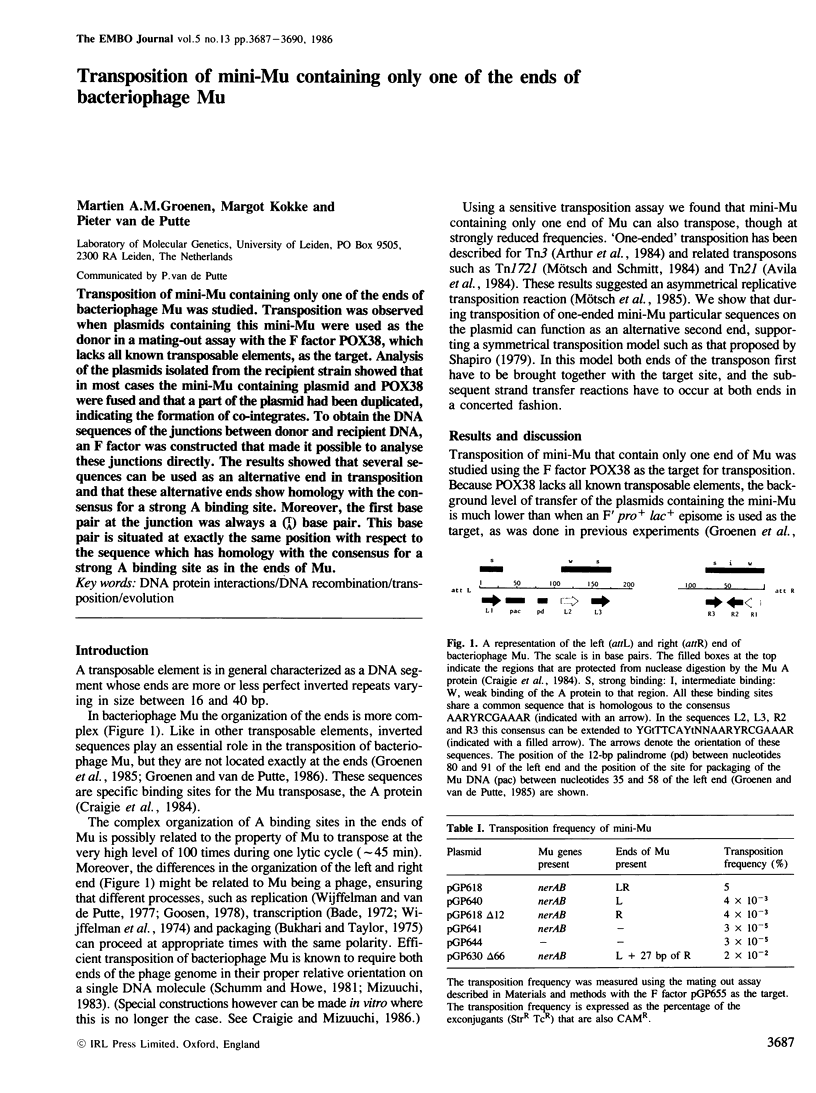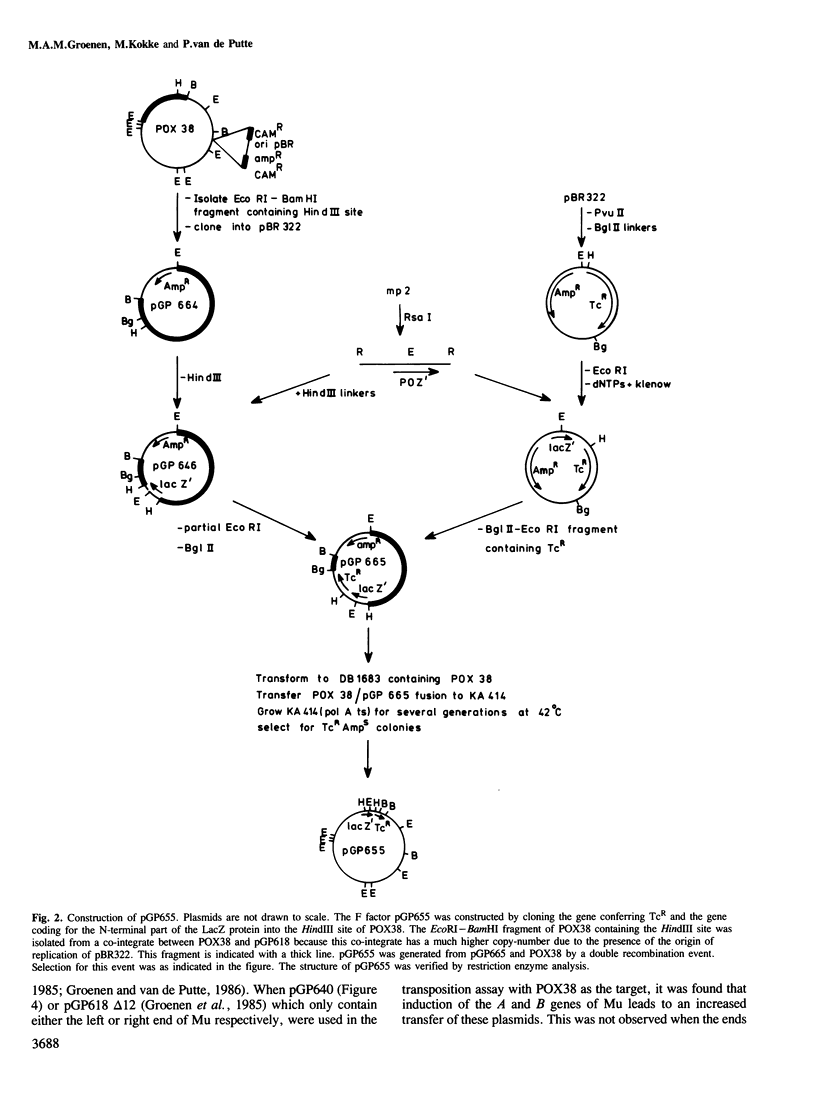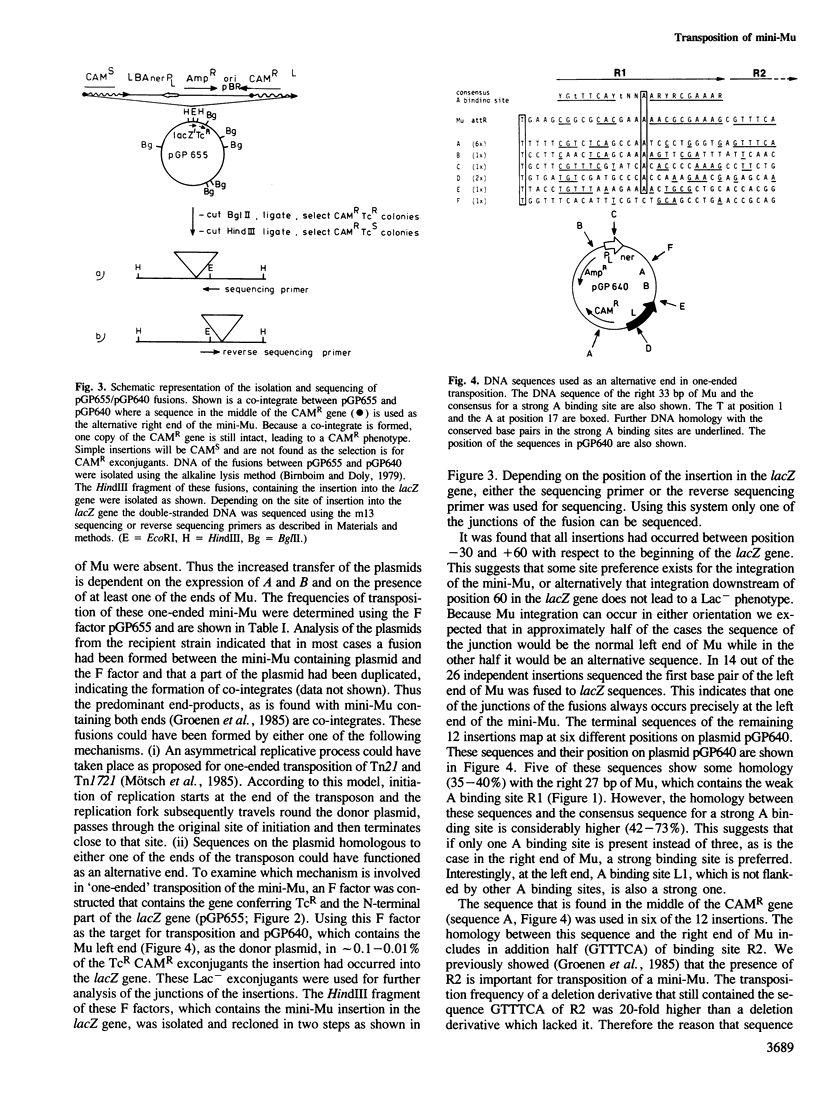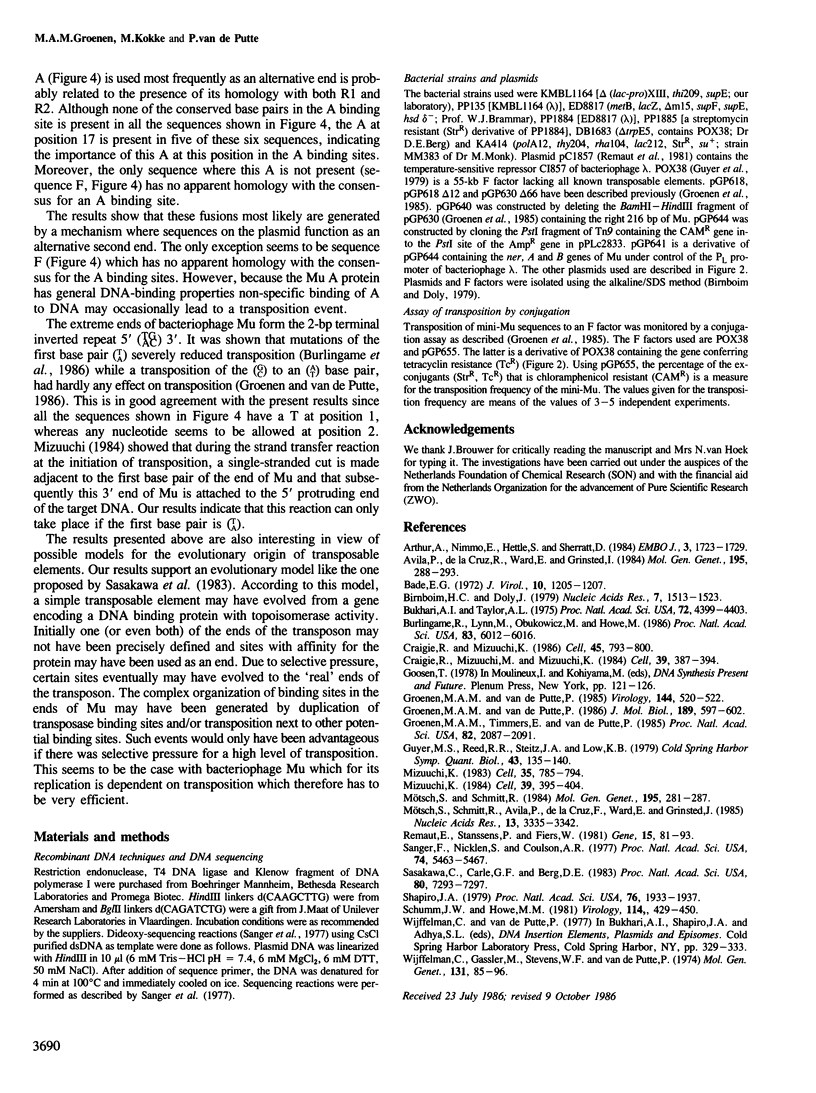Abstract
Transposition of mini-Mu containing only one of the ends of bacteriophage Mu was studied. Transposition was observed when plasmids containing this mini-Mu were used as the donor in a mating-out assay with the F factor POX38, which lacks all known transposable elements, as the target. Analysis of the plasmids isolated from the recipient strain showed that in most cases the mini-Mu containing plasmid and POX38 were fused and that a part of the plasmid had been duplicated, indicating the formation of co-integrates. To obtain the DNA sequences of the junctions between donor and recipient DNA, an F factor was constructed that made it possible to analyse these junctions directly. The results showed that several sequences can be used as an alternative end in transposition and that these alternative ends show homology with the consensus for a strong A binding site. Moreover, the first base pair at the junction was always a (TA) base pair. This base pair is situated at exactly the same position with respect to the sequence which has homology with the consensus for a strong A binding site as in the ends of Mu.
Full text
PDF



Selected References
These references are in PubMed. This may not be the complete list of references from this article.
- Arthur A., Nimmo E., Hettle S., Sherratt D. Transposition and transposition immunity of transposon Tn3 derivatives having different ends. EMBO J. 1984 Aug;3(8):1723–1729. doi: 10.1002/j.1460-2075.1984.tb02038.x. [DOI] [PMC free article] [PubMed] [Google Scholar]
- Avila P., de la Cruz F., Ward E., Grinsted J. Plasmids containing one inverted repeat of Tn21 can fuse with other plasmids in the presence of Tn21 transposase. Mol Gen Genet. 1984;195(1-2):288–293. doi: 10.1007/BF00332761. [DOI] [PubMed] [Google Scholar]
- Bade E. G. Asymmetric transcription of bacteriophage Mu-1. J Virol. 1972 Dec;10(6):1205–1207. doi: 10.1128/jvi.10.6.1205-1207.1972. [DOI] [PMC free article] [PubMed] [Google Scholar]
- Birnboim H. C., Doly J. A rapid alkaline extraction procedure for screening recombinant plasmid DNA. Nucleic Acids Res. 1979 Nov 24;7(6):1513–1523. doi: 10.1093/nar/7.6.1513. [DOI] [PMC free article] [PubMed] [Google Scholar]
- Bukhari A. I., Taylor A. L. Influence of insertions on packaging of host sequences covalently linked to bacteriophage Mu DNA. Proc Natl Acad Sci U S A. 1975 Nov;72(11):4399–4403. doi: 10.1073/pnas.72.11.4399. [DOI] [PMC free article] [PubMed] [Google Scholar]
- Burlingame R. P., Obukowicz M. G., Lynn D. L., Howe M. M. Isolation of point mutations in bacteriophage Mu attachment regions cloned in a lambda::mini-Mu phage. Proc Natl Acad Sci U S A. 1986 Aug;83(16):6012–6016. doi: 10.1073/pnas.83.16.6012. [DOI] [PMC free article] [PubMed] [Google Scholar]
- Craigie R., Mizuuchi K. Role of DNA topology in Mu transposition: mechanism of sensing the relative orientation of two DNA segments. Cell. 1986 Jun 20;45(6):793–800. doi: 10.1016/0092-8674(86)90554-4. [DOI] [PubMed] [Google Scholar]
- Craigie R., Mizuuchi M., Mizuuchi K. Site-specific recognition of the bacteriophage Mu ends by the Mu A protein. Cell. 1984 Dec;39(2 Pt 1):387–394. doi: 10.1016/0092-8674(84)90017-5. [DOI] [PubMed] [Google Scholar]
- Groenen M. A., Timmers E., van de Putte P. DNA sequences at the ends of the genome of bacteriophage Mu essential for transposition. Proc Natl Acad Sci U S A. 1985 Apr;82(7):2087–2091. doi: 10.1073/pnas.82.7.2087. [DOI] [PMC free article] [PubMed] [Google Scholar]
- Groenen M. A., van de Putte P. Analysis of the ends of bacteriophage Mu using site-directed mutagenesis. J Mol Biol. 1986 Jun 20;189(4):597–602. doi: 10.1016/0022-2836(86)90490-0. [DOI] [PubMed] [Google Scholar]
- Groenen M. A., van de Putte P. Mapping of a site for packaging of bacteriophage Mu DNA. Virology. 1985 Jul 30;144(2):520–522. doi: 10.1016/0042-6822(85)90292-2. [DOI] [PubMed] [Google Scholar]
- Mizuuchi K. In vitro transposition of bacteriophage Mu: a biochemical approach to a novel replication reaction. Cell. 1983 Dec;35(3 Pt 2):785–794. doi: 10.1016/0092-8674(83)90111-3. [DOI] [PubMed] [Google Scholar]
- Mizuuchi K. Mechanism of transposition of bacteriophage Mu: polarity of the strand transfer reaction at the initiation of transposition. Cell. 1984 Dec;39(2 Pt 1):395–404. doi: 10.1016/0092-8674(84)90018-7. [DOI] [PubMed] [Google Scholar]
- Mötsch S., Schmitt R., Avila P., de la Cruz F., Ward E., Grinsted J. Junction sequences generated by 'one-ended transposition'. Nucleic Acids Res. 1985 May 10;13(9):3335–3342. doi: 10.1093/nar/13.9.3335. [DOI] [PMC free article] [PubMed] [Google Scholar]
- Mötsch S., Schmitt R. Replicon fusion mediated by a single-ended derivative of transposon Tn1721. Mol Gen Genet. 1984;195(1-2):281–287. doi: 10.1007/BF00332760. [DOI] [PubMed] [Google Scholar]
- Remaut E., Stanssens P., Fiers W. Plasmid vectors for high-efficiency expression controlled by the PL promoter of coliphage lambda. Gene. 1981 Oct;15(1):81–93. doi: 10.1016/0378-1119(81)90106-2. [DOI] [PubMed] [Google Scholar]
- Sanger F., Nicklen S., Coulson A. R. DNA sequencing with chain-terminating inhibitors. Proc Natl Acad Sci U S A. 1977 Dec;74(12):5463–5467. doi: 10.1073/pnas.74.12.5463. [DOI] [PMC free article] [PubMed] [Google Scholar]
- Sasakawa C., Carle G. F., Berg D. E. Sequences essential for transposition at the termini of IS50. Proc Natl Acad Sci U S A. 1983 Dec;80(23):7293–7297. doi: 10.1073/pnas.80.23.7293. [DOI] [PMC free article] [PubMed] [Google Scholar]
- Schumm J. W., Howe M. M. Mu-specific properties of lambda phages containing both ends of Mu depend on the relative orientation of Mu end DNA fragments. Virology. 1981 Oct 30;114(2):429–450. doi: 10.1016/0042-6822(81)90224-5. [DOI] [PubMed] [Google Scholar]
- Shapiro J. A. Molecular model for the transposition and replication of bacteriophage Mu and other transposable elements. Proc Natl Acad Sci U S A. 1979 Apr;76(4):1933–1937. doi: 10.1073/pnas.76.4.1933. [DOI] [PMC free article] [PubMed] [Google Scholar]
- Wijffelman C., Gassler M., Stevens W. F., van de Putte P. On the control of transcription of bacteriophage Mu. Mol Gen Genet. 1974;131(2):85–96. doi: 10.1007/BF00266145. [DOI] [PubMed] [Google Scholar]


